Foreword
Introduction
Background to T-SQL Querying and Programming
Theoretical Background
SQL
Set Theory
Predicate Logic
The Relational Model
The Data Life Cycle
SQL Server Architecture
The ABC Flavors of SQL Server
SQL Server Instances
Databases
Schemas and Objects
Creating Tables and Defining Data Integrity
Creating Tables
Defining Data Integrity
Conclusion
Single-Table Queries
Elements of the SELECT Statement
The FROM Clause
The WHERE Clause
The GROUP BY Clause
The HAVING Clause
The SELECT Clause
The ORDER BY Clause
The TOP and OFFSET-FETCH Filters
A Quick Look at Window Functions
Predicates and Operators
CASE Expressions
NULL Marks
All-at-Once Operations
Working with Character Data
Data Types
Collation
Operators and Functions
The LIKE Predicate
Working with Date and Time Data
Date and Time Data Types
Literals
Working with Date and Time Separately
Filtering Date Ranges
Date and Time Functions
Querying Metadata
Catalog Views
Information Schema Views
System Stored Procedures and Functions
Conclusion
Exercises
1
2
3
4
5
6
7
8
Solutions
1
2
3
4
5
6
7
8
Joins
Cross Joins
ANSI SQL-92 Syntax
ANSI SQL-89 Syntax
Self Cross Joins
Producing Tables of Numbers
Inner Joins
ANSI SQL-92 Syntax
ANSI SQL-89 Syntax
Inner Join Safety
More Join Examples
Composite Joins
Non-Equi Joins
Multi-Join Queries
Outer Joins
Fundamentals of Outer Joins
Beyond the Fundamentals of Outer Joins
Conclusion
Exercises
1-1
1-2 (Optional, Advanced)
2
3
4
5
6 (Optional, Advanced)
7 (Optional, Advanced)
Solutions
1-1
1-2
2
3
4
5
6
7
Subqueries
Self-Contained Subqueries
Self-Contained Scalar Subquery Examples
Self-Contained Multivalued Subquery Examples
Correlated Subqueries
The EXISTS Predicate
Beyond the Fundamentals of Subqueries
Returning Previous or Next Values
Using Running Aggregates
Dealing with Misbehaving Subqueries
Conclusion
Exercises
1
2 (Optional, Advanced)
3
4
5
6
7 (Optional, Advanced)
8 (Optional, Advanced)
Solutions
1
2
3
4
5
6
7
8
Table Expressions
Derived Tables
Assigning Column Aliases
Using Arguments
Nesting
Multiple References
Common Table Expressions
Assigning Column Aliases in CTEs
Using Arguments in CTEs
Defining Multiple CTEs
Multiple References in CTEs
Recursive CTEs
Views
Views and the ORDER BY Clause
View Options
Inline Table-Valued Functions
The APPLY Operator
Conclusion
Exercises
1-1
1-2
2-1
2-2
3 (Optional, Advanced)
4-1
4-2 (Optional, Advanced)
5-1
5-2
Solutions
1-1
1-2
2-1
2-2
3
4-1
4-2
5-1
5-2
Set Operators
The UNION Operator
The UNION ALL Multiset Operator
The UNION Distinct Set Operator
The INTERSECT Operator
The INTERSECT Distinct Set Operator
The INTERSECT ALL Multiset Operator
The EXCEPT Operator
The EXCEPT Distinct Set Operator
The EXCEPT ALL Multiset Operator
Precedence
Circumventing Unsupported Logical Phases
Conclusion
Exercises
1
2
3
4
5 (Optional, Advanced)
Solutions
1
2
3
4
5
Beyond the Fundamentals of Querying
Window Functions
Ranking Window Functions
Offset Window Functions
Aggregate Window Functions
Pivoting Data
Pivoting with Standard SQL
Pivoting with the Native T-SQL PIVOT Operator
Unpivoting Data
Unpivoting with Standard SQL
Unpivoting with the Native T-SQL UNPIVOT Operator
Grouping Sets
The GROUPING SETS Subclause
The CUBE Subclause
The ROLLUP Subclause
The GROUPING and GROUPING_ID Functions
Conclusion
Exercises
1
2
3
4
5
Solutions
1
2
3
4
5
Data Modification
Inserting Data
The INSERT VALUES Statement
The INSERT SELECT Statement
The INSERT EXEC Statement
The SELECT INTO Statement
The BULK INSERT Statement
The Identity Property and the Sequence Object
Deleting Data
The DELETE Statement
The TRUNCATE Statement
DELETE Based on a Join
Updating Data
The UPDATE Statement
UPDATE Based on a Join
Assignment UPDATE
Merging Data
Modifying Data Through Table Expressions
Modifications with TOP and OFFSET-FETCH
The OUTPUT Clause
INSERT with OUTPUT
DELETE with OUTPUT
UPDATE with OUTPUT
MERGE with OUTPUT
Composable DML
Conclusion
Exercises
1
1-1
1-2
1-3
2
3
4
5
6
Solutions
1-1
1-2
1-3
2
3
4
5
Transactions and Concurrency
Transactions
Locks and Blocking
Locks
Troubleshooting Blocking
Isolation Levels
The READ UNCOMMITTED Isolation Level
The READ COMMITTED Isolation Level
The REPEATABLE READ Isolation Level
The SERIALIZABLE Isolation Level
Isolation Levels Based on Row Versioning
Summary of Isolation Levels
Deadlocks
Conclusion
Exercises
1-1
1-2
1-3
1-4
1-5
1-6
2-1
2-2
2-3
2-4
2-5
2-6
3-1
3-2
3-3
3-4
3-5
3-6
3-7
Programmable Objects
Variables
Batches
A Batch As a Unit of Parsing
Batches and Variables
Statements That Cannot Be Combined in the Same Batch
A Batch As a Unit of Resolution
The GO n Option
Flow Elements
The IF . . . ELSE Flow Element
The WHILE Flow Element
An Example of Using IF and WHILE
Cursors
Temporary Tables
Local Temporary Tables
Global Temporary Tables
Table Variables
Table Types
Dynamic SQL
The EXEC Command
The sp_executesql Stored Procedure
Using PIVOT with Dynamic SQL
Routines
User-Defined Functions
Stored Procedures
Triggers
Error Handling
Conclusion
Getting Started
Getting Started with SQL Database
Installing an On-Premises Implementation of SQL Server
1. Obtain SQL Server
2. Create a User Account
3. Install Prerequisites
4. Install the Database Engine, Documentation, and Tools
Downloading Source Code and Installing the Sample Database
Working with SQL Server Management Studio
Working with SQL Server Books Online
Index
About the Author
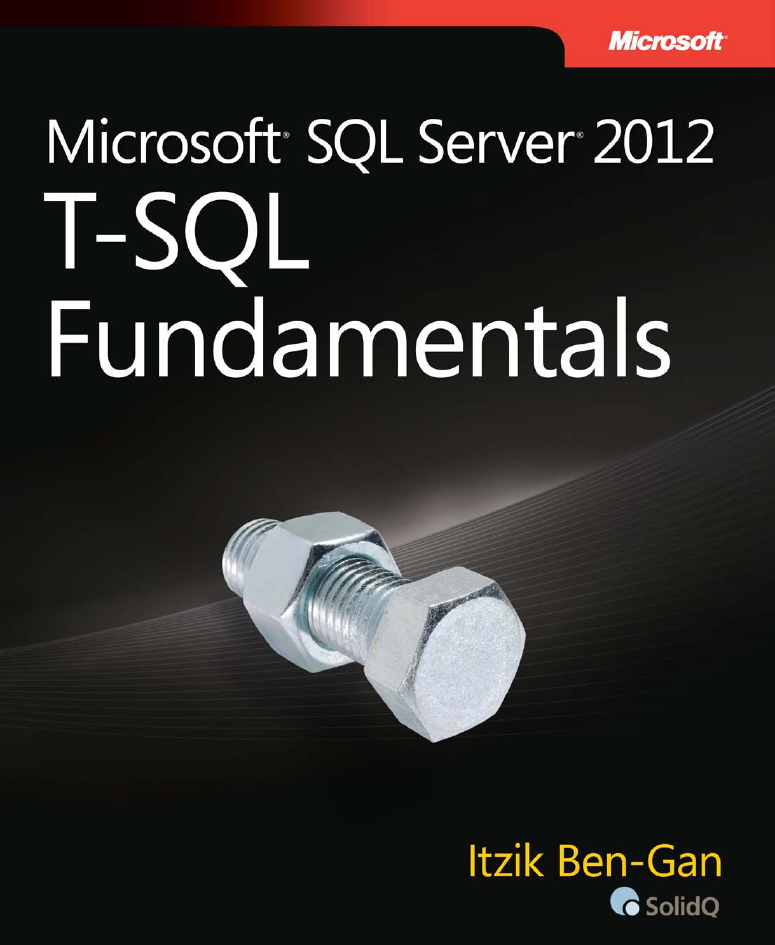
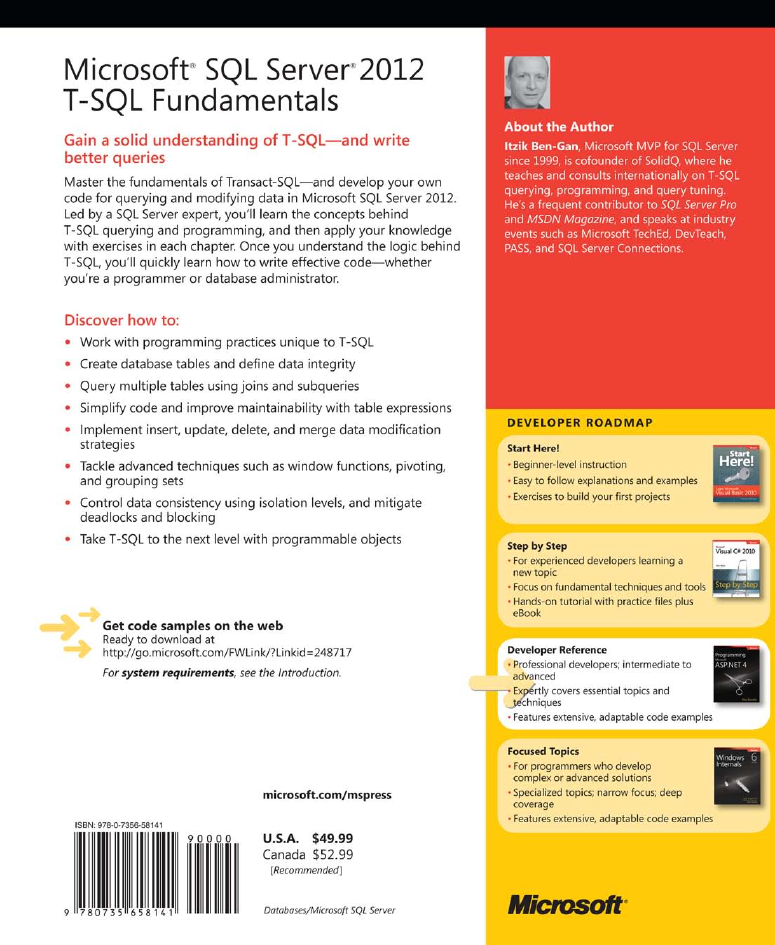
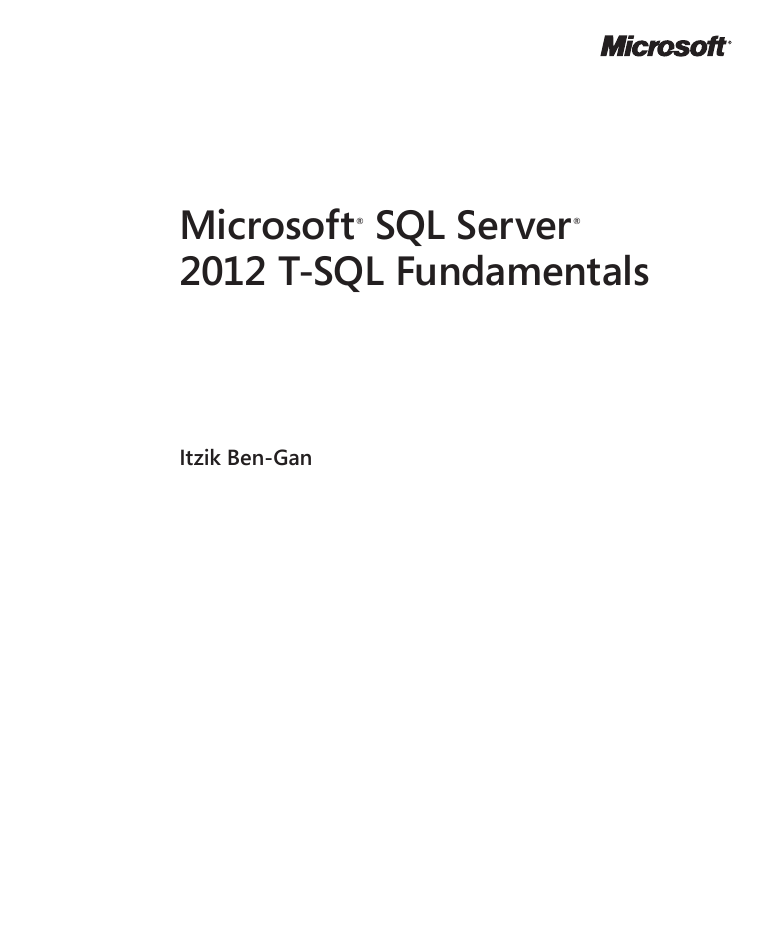
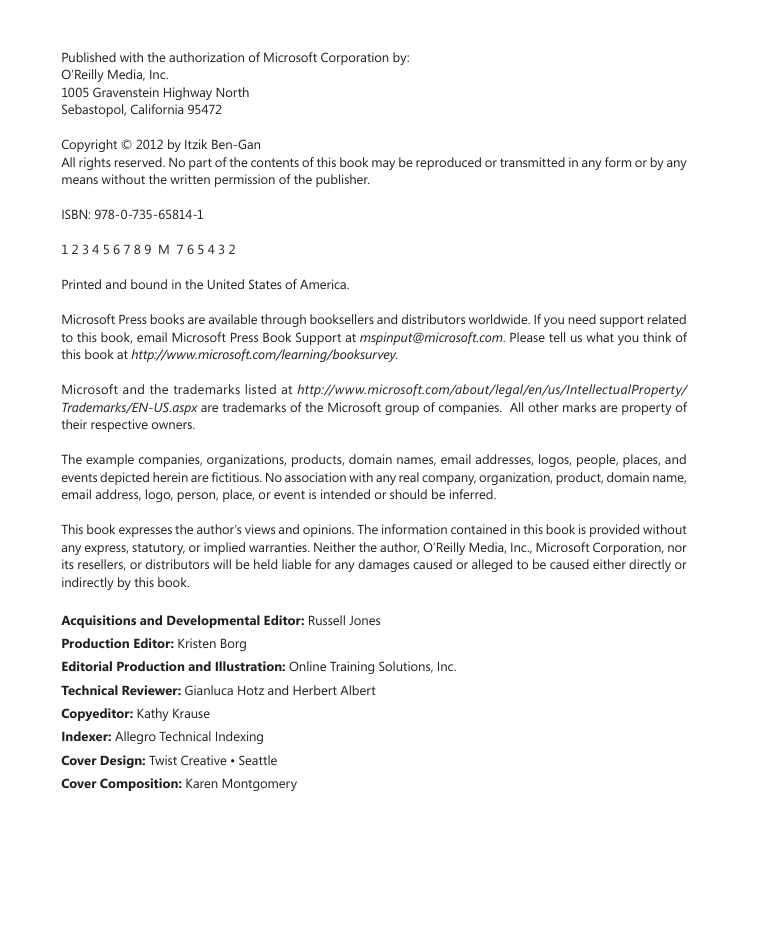


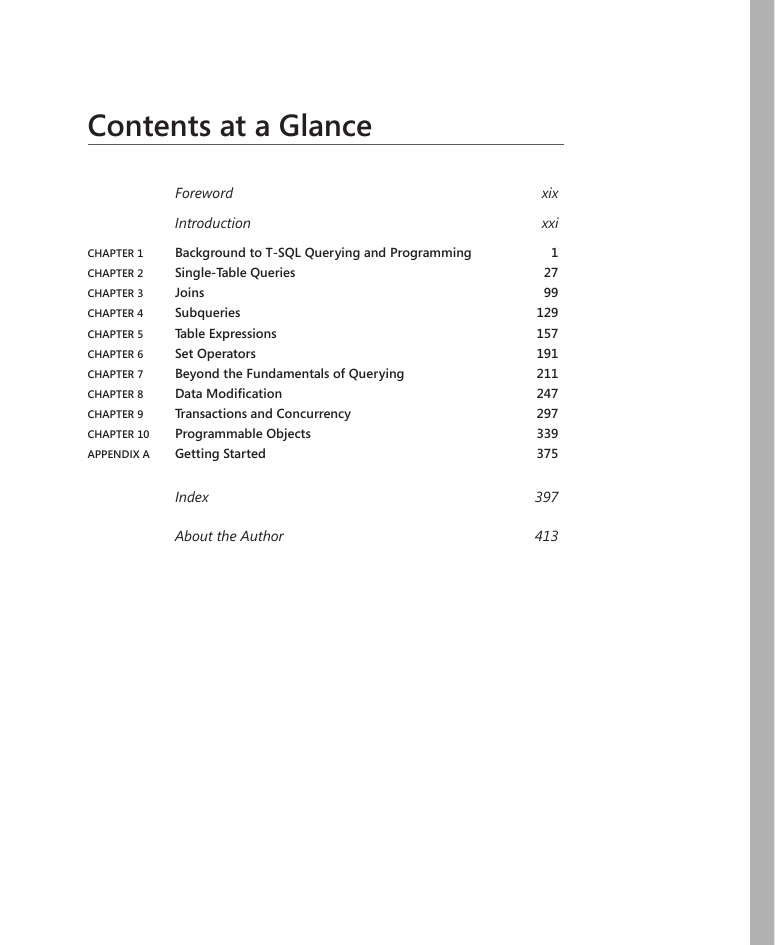









 2023年江西萍乡中考道德与法治真题及答案.doc
2023年江西萍乡中考道德与法治真题及答案.doc 2012年重庆南川中考生物真题及答案.doc
2012年重庆南川中考生物真题及答案.doc 2013年江西师范大学地理学综合及文艺理论基础考研真题.doc
2013年江西师范大学地理学综合及文艺理论基础考研真题.doc 2020年四川甘孜小升初语文真题及答案I卷.doc
2020年四川甘孜小升初语文真题及答案I卷.doc 2020年注册岩土工程师专业基础考试真题及答案.doc
2020年注册岩土工程师专业基础考试真题及答案.doc 2023-2024学年福建省厦门市九年级上学期数学月考试题及答案.doc
2023-2024学年福建省厦门市九年级上学期数学月考试题及答案.doc 2021-2022学年辽宁省沈阳市大东区九年级上学期语文期末试题及答案.doc
2021-2022学年辽宁省沈阳市大东区九年级上学期语文期末试题及答案.doc 2022-2023学年北京东城区初三第一学期物理期末试卷及答案.doc
2022-2023学年北京东城区初三第一学期物理期末试卷及答案.doc 2018上半年江西教师资格初中地理学科知识与教学能力真题及答案.doc
2018上半年江西教师资格初中地理学科知识与教学能力真题及答案.doc 2012年河北国家公务员申论考试真题及答案-省级.doc
2012年河北国家公务员申论考试真题及答案-省级.doc 2020-2021学年江苏省扬州市江都区邵樊片九年级上学期数学第一次质量检测试题及答案.doc
2020-2021学年江苏省扬州市江都区邵樊片九年级上学期数学第一次质量检测试题及答案.doc 2022下半年黑龙江教师资格证中学综合素质真题及答案.doc
2022下半年黑龙江教师资格证中学综合素质真题及答案.doc